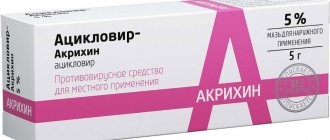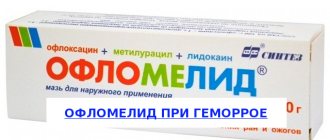Clotrimazole-Akrikhin ointment (tube 1% 20g)
A country
Russia
The country of production may vary depending on the batch of goods. Please check with the operator for detailed information when confirming your order.
Active substance
Clotrimazole
Compound
Tube 20 g
Clotrimazole 1 g per 100 g. Excipients: propylene glycol - 12.5 g, methyl parahydroxybenzoate (nipagin) - 0.2 g, succinic acid - 0.5 g, sodium benzoate - 6 g, emulsion wax - 3 g, castor oil - 14 g, methylcellulose - 3 g, distilled monoglycerides - 1.5 g, purified water - up to 100 g. Ointment for external use is white or almost white, with a slight specific odor.
pharmachologic effect
Antifungal agent of the group of imidazole derivatives for topical use. It has an effect by disrupting the synthesis of ergosterol, which is an integral part of the cell membrane of fungi. Has a wide spectrum of action. Active against dermatophytes, molds, fungi of the genus Candida, Malassezia furfur. Clotrimazole is also active against Corynebacterium minutissimum, Streptococcus spp., Staphylococcus spp., Trichomonas vaginalis.
Indications for use
Fungal infections of the skin and mucous membranes caused by dermatophytes, mold and yeast-like fungi, lichen versicolor, erythrasma, vulvovaginal candidiasis, trichomoniasis, mycoses complicated by secondary pyoderma.
Side effects
Local reactions: allergic contact dermatitis, redness, burning sensation.
Contraindications
Hypersensitivity to clotrimazole, first trimester of pregnancy.
Use during pregnancy and breastfeeding Contraindicated in the first trimester of pregnancy. Experimental studies have shown that when used in high doses, clotrimazole has an embryotoxic effect. It is not known whether clotrimazole is excreted in breast milk. Although clotrimazole is not contraindicated for use during pregnancy and lactation, the potential risk should be considered when choosing antifungal therapy.
Mode of application
For external use, apply to affected areas of the skin 2-3 times a day for 2-4 weeks. When treating the oral cavity, use 1-2 times a day for no more than 7 days. Intravaginally - 100-500 mg for 1-6 days.
special instructions
Dosage forms intended for intravaginal use are not used during menstruation. To prevent reinfection, simultaneous treatment of sexual partners is necessary. Clotrimazole is not recommended for use in ophthalmology.
Interaction with other drugs
When used simultaneously with amphotericin B and nystatin, the activity of clotrimazole is reduced.
Clotrimazole-Akrikhin vaginal tablets 100 mg No. 6
A country
Russia
The country of production may vary depending on the batch of goods. Please check with the operator for detailed information when confirming your order.
Active substance
Clotrimazole
Compound
1 tablet contains: clotrimazole 100 mg.
Excipients: lactose (milk sugar), potato starch, microcrystalline cellulose, citric acid, magnesium stearate. Vaginal tablets are white or almost white, oval, biconvex.
pharmachologic effect
Antifungal agent of the group of imidazole derivatives for topical use. It has an effect by disrupting the synthesis of ergosterol, which is an integral part of the cell membrane of fungi. Has a wide spectrum of action. Active against dermatophytes, molds, fungi of the genus Candida, Malassezia furfur. Clotrimazole is also active against Corynebacterium minutissimum, Streptococcus spp., Staphylococcus spp., Trichomonas vaginalis.
Indications for use
Fungal infections of the skin and mucous membranes caused by dermatophytes, mold and yeast-like fungi, lichen versicolor, erythrasma, vulvovaginal candidiasis, trichomoniasis, mycoses complicated by secondary pyoderma.
Side effects
Local reactions: allergic contact dermatitis, redness, burning sensation.
Contraindications
Hypersensitivity to clotrimazole, first trimester of pregnancy.
Use during pregnancy and breastfeeding Contraindicated in the first trimester of pregnancy. Experimental studies have shown that when used in high doses, clotrimazole has an embryotoxic effect. It is not known whether clotrimazole is excreted in breast milk. Although clotrimazole is not contraindicated for use during pregnancy and lactation, the potential risk should be considered when choosing antifungal therapy.
Mode of application
For external use, apply to affected areas of the skin 2-3 times a day for 2-4 weeks. When treating the oral cavity, use 1-2 times a day for no more than 7 days. Intravaginally - 100-500 mg for 1-6 days.
special instructions
Dosage forms intended for intravaginal use are not used during menstruation. To prevent reinfection, simultaneous treatment of sexual partners is necessary. Clotrimazole is not recommended for use in ophthalmology.
Interaction with other drugs
When used simultaneously with amphotericin B and nystatin, the activity of clotrimazole is reduced.
Clotrimazole-acriquine 1% 20g ointment for external use
pharmachologic effect
Antifungal agent of the group of imidazole derivatives for topical use.
It has an effect by disrupting the synthesis of ergosterol, which is an integral part of the cell membrane of fungi. Has a wide spectrum of action. Active against dermatophytes, molds, fungi of the genus Candida, Malassezia furfur.
Clotrimazole is also active against Corynebacterium minutissimum, Streptococcus spp., Staphylococcus spp., Trichomonas vaginalis.
Composition and release form Clotrimazole-acriquine 1% 20g ointment for external use
Ointment - 100 g:
- Active substance: clotrimazole 1 g.
- Excipients: propylene glycol - 12.5 g, methyl parahydroxybenzoate (nipagin) - 0.2 g, succinic acid - 0.5 g, sodium benzoate - 6 g, emulsion wax - 3 g, castor oil - 14 g, methylcellulose - 3 g, distilled monoglycerides - 1.5 g , purified water - up to 100 g.
20 g - aluminum tubes (1) - cardboard packs.
Description of the dosage form
Ointment for external use is white or almost white in color, with a slight specific odor.
Directions for use and doses
For external use, apply to affected areas of the skin 2-3 times a day for 2-4 weeks.
When treating the oral cavity, use 1-2 times a day for no more than 7 days.
Intravaginally - 100-500 mg for 1-6 days.
Pharmacokinetics
When used externally, clotrimazole penetrates well into various layers of the skin, reaching therapeutic concentrations. When applied topically, a small amount of clotrimazole is absorbed into the blood.
Indications for use Clotrimazole-acriquine 1% 20g ointment for external use
Fungal infections of the skin and mucous membranes caused by dermatophytes, mold and yeast-like fungi, lichen versicolor, erythrasma, vulvovaginal candidiasis, trichomoniasis, mycoses complicated by secondary pyoderma.
Contraindications
Hypersensitivity to clotrimazole, first trimester of pregnancy.
Application of Clotrimazole-acriquine 1% 20g ointment for external use during pregnancy and breastfeeding
Contraindicated in the first trimester of pregnancy.
Experimental studies have shown that when used in high doses, clotrimazole has an embryotoxic effect.
It is not known whether clotrimazole is excreted in breast milk. Although clotrimazole is not contraindicated for use during pregnancy and lactation, the potential risk should be considered when choosing antifungal therapy.
special instructions
Dosage forms intended for intravaginal use are not used during menstruation.
To prevent reinfection, simultaneous treatment of sexual partners is necessary. Clotrimazole is not recommended for use in ophthalmology.
Side effects Clotrimazole-acriquine 1% 20g ointment for external use
Local reactions: allergic contact dermatitis, redness, burning sensation.
Drug interactions
When used simultaneously with amphotericin B and nystatin, the activity of clotrimazole is reduced.
Clotrimazole-Akrikhin ointment for external use 1% 20g
Contraindications
Hypersensitivity to clotrimazole or excipients, pregnancy (first trimester), children under 2 years of age.
With caution: lactation period, pregnancy (II and III trimester).
Directions for use and doses
Externally.
For adults, in the absence of other prescriptions, it is recommended to apply the ointment 2-3 times a day in a thin layer to previously cleansed and dry affected areas of the skin. A single dose for a palm-sized surface area is a column of ointment 5 mm long. Regular use of the ointment is important for successful treatment.
The duration of therapy is individual and depends on the severity and location of the disease. To achieve complete recovery, you should not stop treatment with the ointment immediately after the disappearance of acute symptoms of inflammation or subjective complaints.
The duration of therapy should average about 4 weeks.
Pityriasis versicolor is usually cured within 1-3 weeks, and erythrasma within 2-4 weeks.
For fungal diseases of the skin of the feet, it is recommended to continue therapy for about 2 weeks after the symptoms of the disease have subsided.
In children over 2 years of age, the drug is used in the doses indicated above.
Storage conditions
In a place protected from light, at a temperature not exceeding 15°C.
Keep out of the reach of children.
Best before date
2 years. Do not use after the expiration date.
special instructions
If allergic reactions or irritation occur at the site of application, treatment is stopped.
To prevent reinfection, hygiene rules should be observed.
It is not recommended to apply clotrimazole to the skin in the eye area.
If clinical signs of infection persist after completion of treatment, repeat microbiological testing should be performed to confirm the diagnosis.
Description
Antifungal drug for external use.
Dosage form
Ointment for external use is white or almost white in color, with a slight specific odor.
Use in children
It can be used in children according to indications, in doses and dosage forms recommended according to age. It is necessary to strictly follow the instructions in the instructions for clotrimazole preparations for the use of specific dosage forms of clotrimazole in children of different ages and for contraindications for specific age groups in this category of patients.
Pharmacodynamics
Broad-spectrum antifungal agent for external use. The action of clotrimazole is associated with a disruption in the synthesis of ergosterol, which is part of the cell membrane of fungi, which changes the permeability of the cytoplasmic membrane and causes subsequent cell lysis. In small concentrations it has a fungistatic effect, in large concentrations it has a fungicidal effect, and not only on proliferating cells. At fungicidal concentrations, it interacts with mitochondrial and peroxidase enzymes, resulting in an increase in the concentration of hydrogen peroxide to a toxic level, which also contributes to the destruction of fungal cells.
Clotrimazole exhibits fungicidal and fungistatic activity against dermatomycetes (Trichophyton rubrum, Trichophyton mentagrophytes, Epidermophyton floccosum, Microsporum canis), yeast-like and mold fungi (Candida spp., including Candida albicans; Torulopsis glabrata, genus Rhodotorula, Pityrosporum orbiculare). Active against the causative agent of pityriasis versicolor - Pityrosporum orbiculare (Malassezia furfur). Effective against gram-positive bacteria - the causative agent of erythrasma Corynebacterium minutissimum, as well as Staphylococcus spp., Streptococcus spp., gram-negative bacteria - Bacteroides, Gardnerella vaginalis. In high concentrations it is active against Trichomonas vaginalis.
Has no effect on lactobacilli. Primary resistant variants of sensitive fungi are very rare; the development of secondary resistance in sensitive fungi is also observed in exceptional cases under therapeutic conditions.
Side effects
From the immune system: allergic reactions, incl. urticaria, shortness of breath, arterial hypotension, fainting.
From the skin and subcutaneous tissues: rash, itching, blisters, peeling, pain/discomfort, swelling, burning, irritation, erythema, tingling.
Use during pregnancy and breastfeeding
Use is contraindicated in the first trimester of pregnancy. Use in the II-III trimesters of pregnancy is possible only in cases where the expected benefit to the mother outweighs the potential risk to the fetus.
If it is necessary to use it during lactation, the issue of stopping breastfeeding should be decided.
Interaction
When used simultaneously with amphotericin B and nystatin, the activity of clotrimazole is reduced.
The simultaneous use of intravaginal clotrimazole and tacrolimus, sirolimus orally can lead to an increase in the concentration of the latter in the blood plasma, therefore patients should be monitored for the development of symptoms of their overdose, if necessary, measuring plasma concentrations.
Overdose
Low systemic absorption of the active component of the drug when applied externally makes overdose almost impossible.


